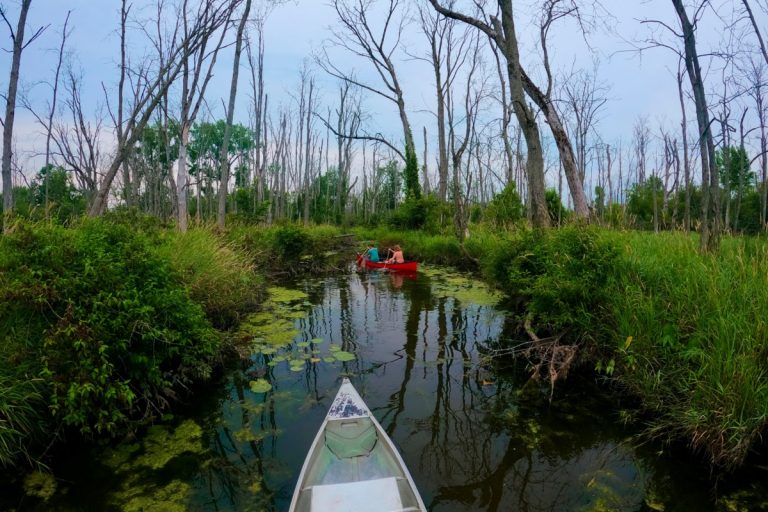Change may be inevitable, but it will come with environmental and social impacts that may outweigh the benefits.
Like a dragonfly darting about its pond home, I’ve been bouncing around the Niagara Peninsula for work and play these past few weeks. There’s a certain irony in traveling to meet and educate others about the inspiring wonders of Niagara’s biodiversity, when countless new “proposed development” signs seem to be popping up everywhere.
A tour I recently booked gave me the opportunity to drive to parts of the peninsula I don’t usually visit, particularly Niagara South. In Niagara-on-the-Lake, St. Catharines, and Niagara Falls, where I visit most often, it’s easier to listen to environmental concerns. I’ve seen a steady rise in signs for large development plans in the area, but in Niagara South, I was shocked to see so many new signs bordering wetlands and forested areas. Now there are too many to count.
I believe my unsettling observation is due to the fact that the southern half of the Niagara Peninsula has always been and still is relatively more densely forested than the northern half. Many of the larger, contiguous habitats in the south have long served as oases for wildlife in the air, on land and in the water. Like a rat nibbling at the edge of a slice of bread, that is exactly what we are witnessing in places like Fort Erie, Port Colborne and south of Niagara Falls.
I’ve written about the impacts of urban sprawl in Niagara from many angles, but this time my focus is simply on how much and how fast it’s happening, and what impact it has on our own minds.
Today, it struck me both professionally and emotionally. The impacts on the environment and human society will be enormous in the near future. Driving through Fort Erie, where proposed development signs pop up every few minutes in front of blocks of lush habitat between the current suburbs, how can this not be a sign of just how much the entire region will change?
The young people who grow up there will likely never get to live in those homes, get to know the neighbors, or teach their children the charms of suburban life, where nature can be a delight in your backyard.Until recently, Fort Erie was a textbook example of how a patchwork of suburban and natural spaces can coexist harmoniously.
There are a lot of clichés in this scenario, and a few misconceptions to clear up in this conversation. The first is, “Well, everyone resists change.” And that’s true. We’ve all felt this way about both big and small problems in our lives.
Sometimes change is just on the borderline of inevitable. I say on the borderline because nothing is truly impossible. But quotas and dictates imposed by power and politics just happen, whether we like it or not. That’s an obvious fact of life. But I do express concern about changes that are unsustainable and that may have longer-term environmental and social impacts that outweigh the immediate positive benefits, such as the proliferation of housing to accommodate an exploding population.
And rather than just saying something, there have actually been scientific studies done on the impact that living in desolate urban areas with no exposure to nature has on mental health and the human psyche.
On that note, as a professional biologist and personal environmentalist, I truly understand the need for more housing. I’m not against development, but I do question where and how development occurs when over 90 percent of the native habitat on the Niagara Peninsula has been lost. What kind of future are we leaving for the next generation? Will they know anything differently?
Sadly, those who move into these new homes will never know what the neighborhood used to be like. I remember riding my bike or scooter with my cousins around Ridgway or Crystal Beach as a kid. Back then, it still had a suburban feel. But between the narrow roads and rows of houses, there were mystical marshes and forests. There were farms with insects buzzing and a thriving economy beneath the soil. I remember buying ice cream at the stands, riding my bike under the warm-hued street lights, listening to the chorus of frogs and the birds chirping in the evening. I will never forget my unforgettable, beautiful, and nostalgic 90s childhood.
Just today, I was driving through some areas of Fort Erie with some friends to explore the creek system by canoe, something I’d never attempted before. With all the fun and success of the exploration, a deeper question was on my mind: “How long will this continue?” The walls of urban sprawl close in on these beautiful waterways from all sides, yet hide in plain sight.
I know I can’t change what’s going to happen. I’m not a developer with millions of dollars, I’m not a politician, and I respect people who want to make money, even a lot of money, but I wonder where the responsibility lies for this drive towards unsustainable development.
Before we know it, kids in Fort Erie and the Niagara region will be riding their bikes through a drab, uninspired landscape where the ice cream has melted and the frogs have stopped croaking.


